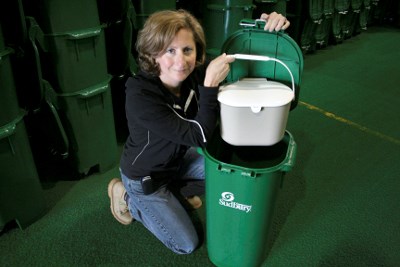The city has opened the door to waste diversion, now it is up to Greater Sudbury residents to walk through it, according to Ward 2 Coun. Jacques Barbeau.
It is time for Sudburians to embrace the green cart program, the councillor said.
“The city has given every opportunity to its residents to recycle, to reduce, to reuse and the residents have to come to the plate. The days of three bags at the curbside need to be over, and we have to get that down to one bag; two immediately, and one bag very soon. People have to get on board.”
Barbeau said the people he knows that are using the program already are very happy with it, and he hopes others get involved.
From what he has seen in his area, the councillor isn't impressed with participation rates.
“Personally, I'm disappointed with what I see in my neighbourhood, with how many people are using it,” Barbeau said.
The councillor said waste diversion is “extremely essential” to Greater Sudbury.
The green cart program, which focuses directly on waste diversion, is one way for residents to better the city, according to Barbeau.
“It's a great program, one that could pay huge dividends to the city. Not only in what we produce, that we can turn into salable fertilizer, but also what we save by not having to build new landfill sites.”
Barbeau cited the landfill in Whitefish as an example of a landfill near its end.
“We look at the landfill site in Whitefish, and it's down to the last two months of operation. In order to replace that landfill site, we're looking at a minimum $50 million.”
Chantal Mathieu, manager of environmental services said the program has started off well.
“It's still a little early on (to measure results), and we're just finished the actually implementation. One of the early signs has been our garbage trucks being able to collect more waste in a larger area (before dumping).”
Some residents seem eager to jump on board, according to Mathieu.
“It's been received quite nicely,” she said. “We're getting quite a few calls from residents who currently are not on the program. They're eager for the next expansion of the program. It's been good. We're quite busy.”
Another reassuring sign for Mathieu, is when residents call in disbelief at how much they've cut their garbage output.
“We've had residents call us and say, 'we're down to one bag of garbage, I never believed it,' we're getting those initial comments. The staff and participants of the pilot project know what the program can do, we're just waiting for that on infiltrate through the community, so people can realize what they're capable of doing.”
The city has “the majority of” six-unit or less residential areas participating in the project already, according to Mathieu.
A large concern for the public with the green cart program, when it was launched in July, was the possibility of carts full of compostable waste attracting bears.
Roughly a month ago, city staff met with the MNR concerning bears, Mathieu said.
“The Onaping/Levack area this year has been the problematic area... Most residents that live out in those rural areas know what they need to do to live with bears, it's those few residents who don't (that are having problems).”
The city will be working with the MNR to help address any bear issues.
In terms of dollars, the program has been cheaper than expected due to the city handling the assembly and distribution of the green carts internally, with its own workforce, according to Mathieu.
Staff was allocated $338,400 annually to continue the pilot project and $1.72 million to launch the program city-wide. These expenditures were funded from the solid waste capital financing reserve fund.
Staff anticipates returning approximately $100,000 to $150,000 of the $1.72 million to the uncommitted reserve fund.
Since the city-wide program was launched in July, $169,200 of the $338,400 will be returned to the reserve fund.
The additional operating cost to co-collect the organic waste with blue box recyclables and to process the material is approximately $326,000 annually, or $5.72 per household per year, according to city statistics.
Expansion of the collection program to other residential units and the industrial, commercial and institutional sector is currently under review by the city. Details are expected to be taken to the solid waste advisory panel later this year and in 2010.
Funds to conduct pilot and review projects have also been requested as part of the 2010 Environmental Services Capital Program. This will include a pilot to collect from non-curbside collection locations, such as apartment buildings, and a review of alternative organic processing methods.
